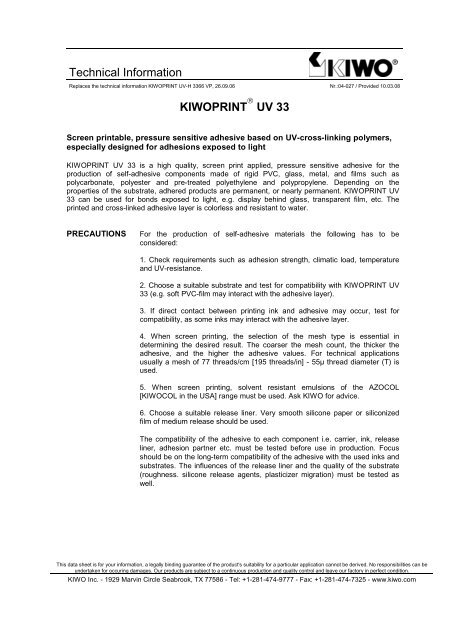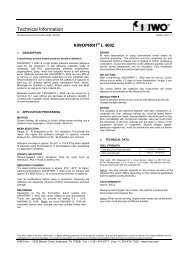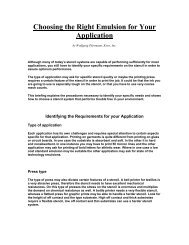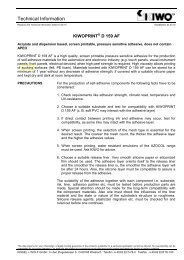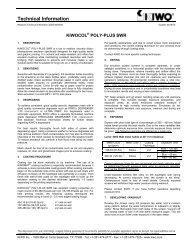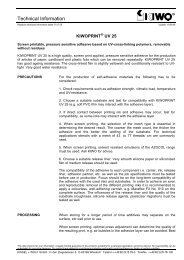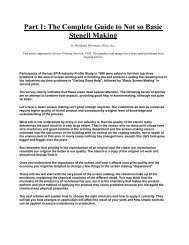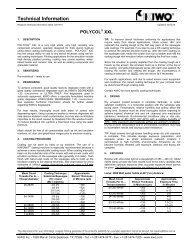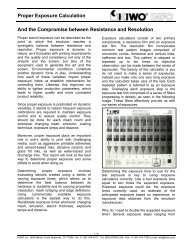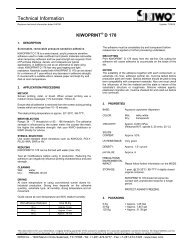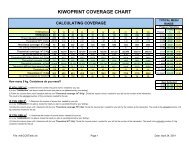Create successful ePaper yourself
Turn your PDF publications into a flip-book with our unique Google optimized e-Paper software.
<strong>Technical</strong> <strong>Information</strong>Replaces the technical information <strong>KIWO</strong>PRINT UV-H 3366 VP, 26.09.06 Nr.:04-027 / Provided 10.03.08<strong>KIWO</strong>PRINT ® UV 33Screen printable, pressure sensitive adhesive based on UV-cross-linking polymers,especially designed for adhesions exposed to light<strong>KIWO</strong>PRINT UV 33 is a high quality, screen print applied, pressure sensitive adhesive for theproduction of self-adhesive components made of rigid PVC, glass, metal, and films such aspolycarbonate, polyester and pre-treated polyethylene and polypropylene. Depending on theproperties of the substrate, adhered products are permanent, or nearly permanent. <strong>KIWO</strong>PRINT UV33 can be used for bonds exposed to light, e.g. display behind glass, transparent film, etc. Theprinted and cross-linked adhesive layer is colorless and resistant to water.PRECAUTIONSFor the production of self-adhesive materials the following has to beconsidered:1. Check requirements such as adhesion strength, climatic load, temperatureand UV-resistance.2. Choose a suitable substrate and test for compatibility with <strong>KIWO</strong>PRINT UV33 (e.g. soft PVC-film may interact with the adhesive layer).3. If direct contact between printing ink and adhesive may occur, test forcompatibility, as some inks may interact with the adhesive layer.4. When screen printing, the selection of the mesh type is essential indetermining the desired result. The coarser the mesh count, the thicker theadhesive, and the higher the adhesive values. For technical applicationsusually a mesh of 77 threads/cm [195 threads/in] - 55µ thread diameter (T) isused.5. When screen printing, solvent resistant emulsions of the AZOCOL[<strong>KIWO</strong>COL in the USA] range must be used. Ask <strong>KIWO</strong> for advice.6. Choose a suitable release liner. Very smooth silicone paper or siliconizedfilm of medium release should be used.The compatibility of the adhesive to each component i.e. carrier, ink, releaseliner, adhesion partner etc. must be tested before use in production. Focusshould be on the long-term compatibility of the adhesive with the used inks andsubstrates. The influences of the release liner and the quality of the substrate(roughness. silicone release agents, plasticizer migration) must be tested aswell.This data sheet is for your information, a legally binding guarantee of the product's suitability for a particular application cannot be derived. No responsibilities can beundertaken for occuring damages. Our products are subject to a continuous production and quality control and leave our factory in perfect condition.<strong>KIWO</strong> Inc. - 1929 Marvin Circle Seabrook, TX 77586 - Tel: +1-281-474-9777 - Fax: +1-281-474-7325 - www.kiwo.com
<strong>Technical</strong> <strong>Information</strong><strong>KIWO</strong>PRINT ® UV 33Page 2 of 4update: 10.03.06PROCESSINGWhen storing the liquid adhesive for a longer period of time, the additives mayascend to the surface, therefore stir thoroughly prior to use.When screen printing, optimal press adjustment can determine the quality of theresulting print, e.g. air bubbles in the adhesive layer can be avoided. Bestprinting results can be achieved with a high mesh tension (25 - 30 N/cm). Thesnap-off should be 3 - 5 mm [0.1 – 0.2 in.], the printing speed slow to medium.The printing image produced using <strong>KIWO</strong>PRINT UV 33 is very smooth. Ingeneral, it is bubble free. Due to the light sensitivity of the liquid adhesive,process the adhesive under yellow light, or at least not in directly illuminatedareas. Thinning with solvents or monomer reducers is neither recommended nornecessary.Drying of UV-pressure sensitive adhesives is not done in the conventional way.<strong>KIWO</strong>PRINT UV 33 chemically cross-links when exposed to UV-light. Usecommon UV-curing units normally used for UV printing inks. The optimum curingrange should be established using one’s own production equipment andconditions. Different exposure intensity causes different cross-linkingresults. Highly cross-linked films of <strong>KIWO</strong>PRINT UV 33 result in high shearstrength. A slightly lower cross-linking produces an adhesive layer withhigher bond values and reduced shear strength. It is absolutely necessary tocontrol the UV-power permanently during production to guarantee uniformproduct quality. Only properly cross-linked adhesive films give highest bondvalues. <strong>KIWO</strong>PRINT UV 33 is very reactive. An exposure dose of 500 – 700mJ/cm² produces an adhesive film suitable for use.ADHERING The bond achieved with self-adhering articles printed with <strong>KIWO</strong>PRINT UV 33can be improved by:1. Ensuring parts are free of dust and mold release agents2. Optimum application temperature: 20 - 50°C [68 – 122°F]3. Additional pressure (approx. 20 N/cm²) with a heated silicone rubber pad (40 -50°C / 104 – 122°F)4. Providing a tension free bond and preventing air bubbles5. Flat and smooth substrate (i.e. pressure molded parts free of burrs/spruemarks).6. Sufficient adhesion surface area relative to total surface area.CLEANING <strong>KIWO</strong>SOLV L 72
<strong>Technical</strong> <strong>Information</strong><strong>KIWO</strong>PRINT ® UV 33Page 3 of 4update: 10.03.06TECHNICAL DATABASISCOLOURUV-reactive polymersTransparent, cloudyVISCOSITY Approx. 10.000 mPas (Brookfield RVT, spindle 5, 20 r/min., 20°C[68°F])SOLIDS CONTENT 100%DENSITY Approx. 1,06 g/cm 3CROSS LINKING The values below were obtained using adhesive films cross-linkedUV LIGHT REACTION as follows:Lamp type:Screen mesh:120 W/cm, mercury vapor lamp36 threads/cm [92 threads/in] – 90µ threaddiameter T [Dry thickness: avg.; 45 µ]Exposure dose: 660 mJ/cm 2Measurements: In Metric units; converted to lbs/in 2 with: (N/cm x0.227)/0.3937 = lbs/in; N/in² x 0.227 = lbs/in²PEEL VALUEApprox. 15N/ inch or 3.4 lb/in (after 1 min adhesion time)Approx. 30 N/ inch or 6.7 lb/in (after 24 h adhesion time)Screen printing on 125 µm polycarbonate film. Peel strength perPSTC 1. Measured with peel tester type L 500 of Lloyd Instruments,load cell 100 N, class 1, DIN EN ISO 7500-1 for tension andpressure, 180° peel test, measured 1 min. and 24 ho urs afteradhering. Peel speed 300 mm/min. [12 in./min.] Adhering topolished stainless steel (material 1.401) with hand roller accordingto PSTC-standard, roll weight 10 pounds, rolled 5x in each direction.Adhesion area: 2,54 x 10 cm [1 x 4 in].DYNAMIC SHEARSTRENGTHSTATIC SHEARSTRENGTHApprox. 135 N/ in² or 30.645 lbs/in²Screen printing on 50 µm polyester film. Measured at 23°C or73.4°F with peel tester type L 500 of Lloyd Instrum ents, load cell2500 N, Class 1, DIN EN ISO 7500-1 for tension and pressure. Peelspeed 0,1 inch/min. Bond area: 1 x 1 inch Bonded to 50 µm PETfilm with a hand roller according to PSTC-standard, roll weight 10pounds, rolled 5x in each direction. Tested after 24 h adhesion time.Approx. 500 sBond area: 1 x 1 inch. Adhering with a hand roller, roll weight 10pounds, rolled 5 x in each direction. Tested after 24 h adhesion
<strong>Technical</strong> <strong>Information</strong><strong>KIWO</strong>PRINT ® UV 33Page 4 of 4update: 10.03.06time. Measured in a drying cabinet at +105°C [221°F ] after 15 min.Shear test is made by adding a load of 1 kg [2.2 lbs].TACK VALUEApprox. 1100 gScreen printing on 50 µm polyester film. Measured with PolykenTack-Tester at 23°C or 73.4°F. Peel speed: 0.5 cm/s or 0.1968in/s. Tested with probe A.HEAT SHEARSTRENGTHApprox. +90°C or +194°FScreen printing on 50 µm polyester film. Tested according toASTM D 4498 (SAFT = Shear Adhesion Failure Temperature).Bond area of 1 x 1 inch, adhering to polyester film with a handroller (10 pounds, 5x in each direction). Test after 24 h. After 15min at +40°C / 104°F in a drying chamber, shear tes t with anadditional weight of 500 g / 17.635 oz. Start of test at 40°C / 104°;then temperature raised in steps of 5°C every 10 mi n., until thetest sample dropped.HEALTH HAZARDS/ENVIRONMENTALPROTECTIONSTORAGEPlease follow information given in the material safety data sheet.6 months (at 20–25° / 68-77°F and tightly closed o riginalcontainer).Notice: Do not store or transport at a temperature over 40°C /104°F!Protect against direct sun exposure or other UV-light source.Thank you for choosing <strong>KIWO</strong>.


